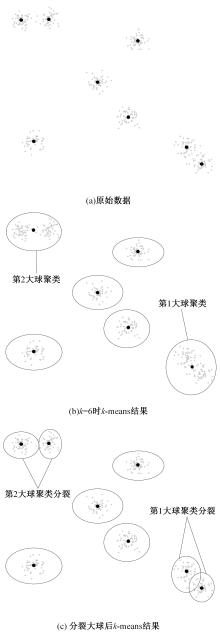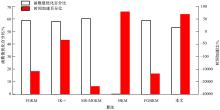Journal of Jilin University(Engineering and Technology Edition) ›› 2022, Vol. 52 ›› Issue (6): 1434-1441.doi: 10.13229/j.cnki.jdxbgxb20210098
Incremental k⁃means clustering algorithm based on multi⁃sphere splitting
Fu-heng QU1( ),Chao-yue QIAN1,Yong YANG1,2(
),Chao-yue QIAN1,Yong YANG1,2( ),Yang LU1,Jian-fei SONG1,Ya-ting HU3
),Yang LU1,Jian-fei SONG1,Ya-ting HU3
- 1.College of Computer Science and Technology,Changchun University of Science and Technology,Changchun 130022,China
2.College of Education,Changchun Normal University,Changchun 130032,China
3.College of Information Technology,Jilin Agricultural University,Changchun 130118,China
CLC Number:
- TP391
| 1 | 金晓民,张丽萍. 基于最小生成树的多层次k-means聚类算法及其在数据挖掘中的应用[J]. 吉林大学学报: 理学版,2018,56(5): 1187-1192. |
| Jin Xiao-min, Zhang Li-ping. Multi-level k-means clustering algorithm based on minimum spanning tree and its application in data mining[J]. Journal of Jilin University(Science Edition),2018, 56(5): 1187-1192. | |
| 2 | 张杰,卓灵,朱韵攸. 一种k-means聚类算法的改进与应用[J]. 电子技术应用,2015,41(1): 125-128, 131. |
| Zhang Jie, Zhuo Ling, Zhu Yun-xiao. Improvement and application of a k-means clustering algorithm[J]. Application of Electronic Technology, 2015, 41(1): 125-128, 131. | |
| 3 | 刘仲民,李战明,李博皓,等. 基于稀疏矩阵的谱聚类图像分割算法[J]. 吉林大学学报: 工学版,2017,47(4): 1308-1313. |
| Liu Zhong-min, Li Zhan-ming, Li Bo-hao, et al. Spectral clustering image segmentation based on sparse matrix[J]. Journal of Jilin University(Engineering and Technology Edition), 2017, 47(4): 1308-1313. | |
| 4 | Elkan C. Using the triangle inequality to accelerate k-means[C]∥Proceedings of the 20th International Conference on Machine Learning,La Jolla, California, 2003: 147-153. |
| 5 | Hamerly G. Making k-means even faster[C]∥Proceedings of the 2010 SIAM International Conference on Data Mining, Columbus, Ohio, USA, 2010: 130-140. |
| 6 | Drake J, Hamerly G. Accelerated k-means with adaptive distance bounds[C]∥5th NIPS Workshop on Optimization for Machine Learning, Lake Tahoe, California, America, 2012. |
| 7 | Newling J, Fleuret F. Fast k-means with accurate bounds[C]∥ICML'16: Proceedings of the 33rd International Conference on International Conference on Machine Learning, New York, America, 2016: 936-944. |
| 8 | Ding Y F, Zhao Y, Shen X P, et al. Yinyang k-means: a drop-in replacement of the classic k-means with consistent speedup[C]∥Proceedings of the 32nd International Conference on Machine Learning, Lila, France, 2015: 579-587. |
| 9 | Xia S Y, Peng D W, Meng D Y, et al. Ball k-means: fast adaptive clustering with no bounds[J]. IEEE Transactions on Pattern Analysis and Machine Intelligence, 2022, 44(1): 87-99. |
| 10 | Likas A, Vlassis N, Verbeek J J. The global k-means clustering algorithm[J]. Pattern Recognition, 2003, 36(2): 451-461. |
| 11 | Bagirov A M. Modified global k-means algorithm for minimum sum-of-squares clustering problems[J]. Pattern Recognition, 2008, 41(10): 3192-3199. |
| 12 | Bagirov A M, Ugon J, Webb D. Fast modified global k-means algorithm for incremental cluster construction[J]. Pattern Recognition, 2011, 44(4): 866-876. |
| 13 | Ordin B, Bagirov A M. A heuristic algorithm for solving the minimum sum-of-squares clustering problems[J]. Journal of Global Optimization, 2015, 61(2): 341-361. |
| 14 | Xie J, Jiang S, Xie W, et al. An efficient global k-means clustering algorithm[J]. Journal of Computers, 2011, 6(2): 271-279. |
| 15 | Yang X, Li Y, Sun Y, et al. Fast and robust rbf neural network based on global k-means clustering with adaptive selection radius for sound source angle estimation[J]. IEEE Transactions on Antennas and Propagation, 2018, 66(6): 3097-3107. |
| 16 | 于剑,程乾生. 模糊聚类方法中的最佳聚类数的搜索范围[J]. 中国科学,2002,32(2): 275-280. |
| Yu Jian, Cheng Qian-sheng. The search range of optimal cluster number in fuzzy clustering method[J]. China Science, 2002, 32(2): 275-280. | |
| 17 | Hartigan J A, Wong M A. Algorithm AS 136: a k-means clustering algorithm[J]. Applied Statistics, 1979, 28(1): 100-108. |
| 18 | Ismkhan H. Ik-means-+: an iterative clustering algorithm based on an enhanced version of the k-means[J]. Pattern Recognition, 2018, 79: 402-413. |
| [1] | Zhuo-jun XU,Wen-ting YANG,Cheng-zhi YANG,Yan-tao TIAN,Xiao-jun WANG. Improved residual neural network algorithm for radar intra-pulse modulation classification [J]. Journal of Jilin University(Engineering and Technology Edition), 2021, 51(4): 1454-1460. |
| [2] | Zhe-ming YUAN,Hong-jie YUAN,Yu-xuan YAN,Qian LI,Shuang-qing LIU,Si-qiao TAN. Automatic recognition and classification of field insects based on lightweight deep learning model [J]. Journal of Jilin University(Engineering and Technology Edition), 2021, 51(3): 1131-1139. |
| [3] | Fu LIU,Lu LIU,Tao HOU,Yun LIU. Night road image enhancement method based on optimized MSR [J]. Journal of Jilin University(Engineering and Technology Edition), 2021, 51(1): 323-330. |
| [4] | Feng⁃wen ZHAI,Jian⁃wu DANG,Yang⁃ping WANG,Jing JIN,Wei⁃wei LUO. Extended contour⁃based fast affine invariant feature extracting [J]. Journal of Jilin University(Engineering and Technology Edition), 2019, 49(4): 1345-1356. |
| [5] | LIU Fu, LAN Xu-teng, HOU Tao, KANG Bing, LIU Yun, LIN Cai-xia. Metagenomic clustering method based on k-mer frequency optimization [J]. Journal of Jilin University(Engineering and Technology Edition), 2018, 48(5): 1593-1599. |
| [6] | GENG Qing-tian, YU Fan-hua, ZHAO Hong-wei, WANG Chuang. New algorithm of flame detection based on color features [J]. 吉林大学学报(工学版), 2014, 44(6): 1787-1792. |
| [7] | GU Bo-yu,SUN Jun-xi,LI Hong-zuo,LIU Hong-xi,LIU Guang-wen. Face recognition based on eigen weighted modular two-directional two-dimensional PCA [J]. 吉林大学学报(工学版), 2014, 44(3): 828-833. |
| [8] | CHEN Wan-zhong, SUN Bao-feng, GAO Ren-jie, LEI Jun. Pattern recognition of human arm motion based on neural network ensemble method [J]. 吉林大学学报(工学版), 2013, 43(增刊1): 69-73. |
| [9] | YANG Dong-feng, MA Xiu-lian. Identification of egg shell crack based on fractal texture analysis [J]. 吉林大学学报(工学版), 2011, 41(增刊1): 348-352. |
| [10] | HU Hong-yu, WANG Qing-nian, QU Zhao-wei, LI Zhi-hui. Spatial pattern recognition and abnormal traffic behavior detection of moving object [J]. 吉林大学学报(工学版), 2011, 41(6): 1598-1602. |
| [11] | WANG Dan, ZHANG Xiang-He, ZHANG Li, REN Lou-Quan. Multidimensional and multiresolution biomimetic recognition method and its application [J]. 吉林大学学报(工学版), 2011, 41(02): 408-0412. |
| [12] | WANG Li-min,ZANG Xue-bai,CAO Chun-hong. Data mining model of decision forest based on generalized informaion theory [J]. 吉林大学学报(工学版), 2010, 40(01): 155-0158. |
| [13] | WANG Xu,CHEN Yong-gang,YANG Yin-sheng . DEA-DA model with interval numbers and its sensitivity analysis [J]. 吉林大学学报(工学版), 2009, 39(03): 716-0720. |
| [14] | LI Lun-bo, MA Guang-fu . Identification of degraded traffic sign symbols using radial basis probabilistic neural networks [J]. 吉林大学学报(工学版), 2008, 38(06): 1429-1433. |
| [15] | TAN Mei, YIN Yi-long, YANG Wei-hui. Method at Region Level for Ridge Distance [J]. 吉林大学学报(工学版), 2005, 35(05): 537-0541. |
|
||



